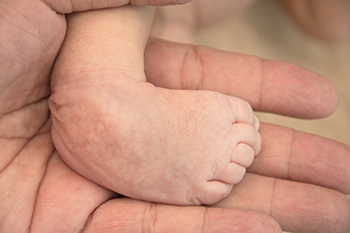Items filtered by date: November 2023
Clubfoot and Metatarsus Adductus Are Congenital Foot Conditions

The journey of infancy unveils the uniqueness of every child, including the diverse ways their little feet may develop. Clubfoot and metatarsus adductus stand out as congenital foot conditions that influence the early stages of a child's mobility. Clubfoot presents as a deformity where the foot turns inward and downward, affecting the bones, muscles, tendons, and ligaments. Conversely, metatarsus adductus, involves a curved or turned in position of the front part of the foot. Both conditions are noticeable from birth and can be attributed to a combination of genetic and environmental factors. While clubfoot necessitates gentle manipulations and casting to guide the foot into proper alignment, metatarsus adductus often resolves with stretching exercises and wearing proper footwear. Understanding these congenital foot conditions empowers parents and podiatrists to initiate timely interventions, providing the best foundation for a child's healthy and active future. If your child has been born with one of these foot conditions, it is strongly suggested that you are under the care of a podiatrist who can promptly begin the correct treatment.
Congenital foot problems require immediate attention to avoid future complications. If you have any concerns, contact Kenneth Williams, DPM of Texas. Our doctor can provide the care you need to keep you pain-free and on your feet.
Congenital foot problems are deformities affecting the feet, toes, and/or ankles that children are born with. Some of these conditions have a genetic cause while others just happen. Some specific foot ailments that children may be born with include clubfeet, polydactyly/macrodactyly, and cleft foot. There are several other foot anomalies that can occur congenitally. What all of these conditions have in common is that a child may experience difficulty walking or performing everyday activities, as well as trouble finding footwear that fits their foot deformity. Some of these conditions are more serious than others. Consulting with a podiatrist as early as possible will help in properly diagnosing a child’s foot condition while getting the necessary treatment underway.
What are Causes of Congenital Foot Problem?
A congenital foot problem is one that happens to a child at birth. These conditions can be caused by a genetic predisposition, developmental or positional abnormalities during gestation, or with no known cause.
What are Symptoms of Congenital Foot Problems?
Symptoms vary by the congenital condition. Symptoms may consist of the following:
- Clubfoot, where tendons are shortened, bones are shaped differently, and the Achilles tendon is tight, causing the foot to point in and down. It is also possible for the soles of the feet to face each other.
- Polydactyly, which usually consists of a nubbin or small lump of tissue without a bone, a toe that is partially formed but has no joints, or an extra toe.
- Vertical talus, where the talus bone forms in the wrong position causing other bones in the foot to line up improperly, the front of the foot to point up, and the bottom of the foot to stiffen, with no arch, and to curve out.
- Tarsal coalition, when there is an abnormal connection of two or more bones in the foot leading to severe, rigid flatfoot.
- Cleft foot, where there are missing toes, a V-shaped cleft, and other anatomical differences.
- Macrodactyly, when the toes are abnormally large due to overgrowth of the underlying bone or soft tissue.
Treatment and Prevention
While there is nothing one can do to prevent congenital foot problems, raising awareness and receiving neonatal screenings are important. Early detection by taking your child to a podiatrist leads to the best outcome possible.
If you have any questions please feel free to contact our office located in San Antonio and Beeville, TX . We offer the newest diagnostic tools and technology to treat your foot and ankle needs.
What Is Gout and Who Is at Risk?

Gout is a form of inflammatory arthritis characterized by sudden, severe attacks of pain, redness, and tenderness in joints, often at the base of the big toe. It is caused by elevated levels of uric acid in the blood, which can form needle-like crystals in a joint, triggering inflammation and intense pain. Risk factors for developing gout can include a diet rich in purines, found in red meat, seafood, and alcohol. Additionally, obesity, and certain health conditions such as high blood pressure, diabetes, and kidney problems may also lead to developing gout. Men and postmenopausal women are more susceptible. If you think you may have gout and you have pain in your big toe, it is suggested that you make an appointment with a podiatrist for an evaluation and treatment that can restore your comfort.
Gout is a foot condition that requires certain treatment and care. If you are seeking treatment, contact Kenneth Williams, DPM from Texas. Our doctor will treat your foot and ankle needs.
What Is Gout?
Gout is a type of arthritis caused by a buildup of uric acid in the bloodstream. It often develops in the foot, especially the big toe area, although it can manifest in other parts of the body as well. Gout can make walking and standing very painful and is especially common in diabetics and the obese.
People typically get gout because of a poor diet. Genetic predisposition is also a factor. The children of parents who have had gout frequently have a chance of developing it themselves.
Gout can easily be identified by redness and inflammation of the big toe and the surrounding areas of the foot. Other symptoms include extreme fatigue, joint pain, and running high fevers. Sometimes corticosteroid drugs can be prescribed to treat gout, but the best way to combat this disease is to get more exercise and eat a better diet.
If you have any questions please feel free to contact our office located in San Antonio and Beeville, TX . We offer the newest diagnostic and treatment technologies for all your foot and ankle needs.
Ease Painful Feet With Orthotics

Custom orthotics can be used to relieve foot pain and discomfort. They're also used to treat various foot conditions and deformities. Flat feet, bunions, and Morton's neuroma are just a few of the foot conditions that have been known to benefit from the use of orthotics.
Comfy feet are happy feet! Contact us today.
Definition and Risk Factors of Plantar Warts

Plantar warts, small growths caused by the human papillomavirus, or HPV, often appear on the soles of the feet. Unlike common warts, which typically grow on the hands, plantar warts can be painful due to the pressure exerted on the soles when walking or standing. These warts may have a rough, grainy appearance with tiny black dots, which are actually clotted blood vessels. Several risk factors increase the likelihood of developing plantar warts. Close contact with the virus, such as walking barefoot in damp and communal areas like locker rooms, swimming pools, or public showers, can put your feet at risk. Additionally, those with a weakened immune system, such as individuals with diabetes or HIV, are more susceptible to plantar warts. Constantly moist or sweaty feet can provide an ideal environment for the virus to thrive. If you have developed a plantar wart, it is strongly suggested that you consult a podiatrist who can provide relief with appropriate treatment methods.
Plantar warts can be very uncomfortable. If you need your feet checked, contact Kenneth Williams, DPM from Texas. Our doctor will assist you with all of your foot and ankle needs.
About Plantar Warts
Plantar warts are the result of HPV, or human papillomavirus, getting into open wounds on the feet. They are mostly found on the heels or balls of the feet.
While plantar warts are generally harmless, those experiencing excessive pain or those suffering from diabetes or a compromised immune system require immediate medical care. Plantar warts are easily diagnosed, usually through scraping off a bit of rough skin or by getting a biopsy.
Symptoms
- Lesions on the bottom of your feet, usually rough and grainy
- Hard or thick callused spots
- Wart seeds, which are small clotted blood vessels that look like little black spots
- Pain, discomfort, or tenderness of your feet when walking or standing
Treatment
- Freezing
- Electric tool removal
- Laser Treatment
- Topical Creams (prescription only)
- Over-the-counter medications
To help prevent developing plantar warts, avoid walking barefoot over abrasive surfaces that can cause cuts or wounds for HPV to get into. Avoiding direct contact with other warts, as well as not picking or rubbing existing warts, can help prevent the further spread of plantar warts. However, if you think you have developed plantar warts, speak to your podiatrist. He or she can diagnose the warts on your feet and recommend the appropriate treatment options.
If you have any questions please feel free to contact our office located in San Antonio and Beeville, TX . We offer the newest diagnostic and treatment technologies for all your foot and ankle needs.
Understanding Broken Toes and Their Symptoms

A broken toe, or toe fracture, is a painful injury that occurs when one or more of the toe bones known as the phalanges become cracked or fractured. This injury typically results from a sudden and forceful impact or trauma, like dropping a heavy object on the toe, stubbing it, or experiencing a direct blow during sports or accidents. The symptoms of a broken toe are quite distinct. Severe pain and immediate discomfort are common, often accompanied by swelling, bruising, and tenderness around the affected area. The toe may appear misshapen or out of alignment, making it challenging to move or bear weight. If the broken toe is severe, some individuals hear a cracking or popping sound at the time of injury. It is crucial to seek medical attention from a podiatrist if you suspect a broken toe. Recognizing the signs and seeking timely care can help prevent complications and expedite the recovery process. If you have broken your toe, it is suggested that you contact this type of doctor who can perform an accurate diagnosis and guide you toward the appropriate treatment method.
A broken toe can be very painful and lead to complications if not properly fixed. If you have any concerns about your feet, contact Kenneth Williams, DPM from Texas. Our doctor will treat your foot and ankle needs.
What to Know About a Broken Toe
Although most people try to avoid foot trauma such as banging, stubbing, or dropping heavy objects on their feet, the unfortunate fact is that it is a common occurrence. Given the fact that toes are positioned in front of the feet, they typically sustain the brunt of such trauma. When trauma occurs to a toe, the result can be a painful break (fracture).
Symptoms of a Broken Toe
- Throbbing pain
- Swelling
- Bruising on the skin and toenail
- The inability to move the toe
- Toe appears crooked or disfigured
- Tingling or numbness in the toe
Generally, it is best to stay off of the injured toe with the affected foot elevated.
Severe toe fractures may be treated with a splint, cast, and in some cases, minor surgery. Due to its position and the pressure it endures with daily activity, future complications can occur if the big toe is not properly treated.
If you have any questions please feel free to contact our office located in San Antonio and Beeville, TX . We offer the newest diagnostic and treatment technologies for all your foot and ankle needs.
